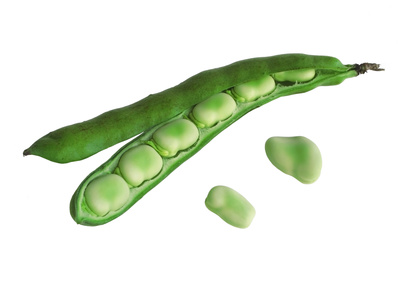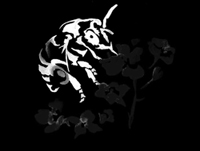Broad Beans (Vicia faba)

Mating & Breeding System: Vicia faba includes two cultivated varieties, the broad bean and the field bean. Flowers are hermaphroditic (they have both male and female parts). Plants produce many more flowers than they can develop to maturity, and many are aborted either before or after fertilization.
Both self- and cross-pollination are possible and may be facilitated by visiting bees. Like other legumes, the flowers are adapted to 'trip' when visited by a pollinator, which dusts pollen on the visitor. This trait suggests that cross-pollination is desirable in this crop.
Pollination, Quality & Yield: The presence of insect pollinators has a beneficial effect on total yield and size of individual seed, although results vary widely across studies in different parts of the world. Honey bees are capable of pollinating V. faba, but larger bees do a superior job.
A typical crop is a mix of low-yielding inbred and high-yielding hybrid plants. Inbred plants must be cross-pollinated to set fruit, and hybrid plants will only produce high yields if they are cross-pollinated.
Hybrid plants will self-fertilize if pollinators are lacking. However, the following year the progeny of self-fertilized hybrid plants will be inbred, and produce very few seeds without insect pollination. Thus, it is important to make sure that a given crop has adequate insect pollinators, to ensure a good yield the following year as well. The presence of bees also allows the plant to set fruit earlier.
Pollination Recommendations: The recommended stocking rate is 2.5 honey bee colonies per hectare. Honey bees are known to be effective pollinators of faba beans in warmer climates, but it is not clear how effective they are in temperate zones such as Ontario. It is also possible that the use of too many hives may be unnecessary, as the plants will only set fruit from a portion of their flowers no matter how many are pollinated, and abort the rest.
Plants in small fields and those near the edge of large fields are more productive, demonstrating the value of wild pollinators in this crop. In Canada, bumble bees, miner bees (Andrenidae) and digger bees (Apidae: Anthophorinae) are the most important wild pollinators.
Some researchers have suggested that adding honey bees to fields larger than 12 hectares could be beneficial to compensate for the lack of wild pollinators in these larger fields. However, this has not been rigorously investigated.
Because honey bees have difficulty reaching nectar in the faba bean, beekeepers may wish to supplement their hives with sugar syrup while they collect pollen on this crop.
References
Bond, D.A. & Kirby, E.J.M. 1999. Anthophora plumipes (Hymenoptera: Anthophoridae) as a pollinator of broad bean (Vicia faba major). Journal of Apicultural Research 38:199-203.
Bond, D.A. & Pope, M. 1974. Factors affecting the proportion of crossbred and self-bred seed obtained from field bean (Vicia faba L.) crops. Journal of the Agricultural Society of Cambridge 83:343-351.
Crofton, G.R.A. 1996. A review of pollination and pod setting in faba beans (Vicia faba L.). Plant Varieties and Seeds 9:29-35.
Free, J.B. & Williams, I.H. 1976. Pollination as a factor limiting the yield of field bean (Vicia faba L.) Journal of the Agricultural Society of Cambridge 87:395-399.
Hebblethwaite, P.D., Scott, R.K., & Kogbe, J.O.S. 1984. The effect of irrigation and bees on the yield and yield components of Vicia faba L. In Hebblethwaite, P.D. et al. (eds.) Vicia faba: Agronomy, Physiology, and Breeding. Martinus Nijhoff, The Hague.
McVetty, P. B. E. & Nugent-Rigby, J. 1984. Natural cross pollination of faba beans (Vicia faba L.) grown in Manitoba. Canadian Journal of Plant Science 64:43-46.
Mussalam, I.W., Haddad, N.J., Tawaha, A.R.M., & Migdadi, O.S. 2004. The importance of bee-pollination in four genotypes of faba bean (Vicia faba L.). International Journal of Agriculture and Biology 6:9-12.
Scott-Dupree, C.D., Winston, M., Hergert, G., Jay, S.C., Nelson, D., Gates, J., Termeer, B., & Otis, G. 1995. A guide to managing bees for crop pollination. Canadian Association of Professional Apiculturists, Aylesford NS.
Somerville, D.C. 1999. Honeybees (Apis mellifera L.) increase yields of faba beans (Vicia faba L.) in New South Wales while maintaining adequate protein requirements from faba bean pollen. Australian Journal of Experimental Agriculture 39:1001-1005.
Stoddard, F.L. & Bond, D.A. 1987. The pollination requirements of the faba bean. Bee World 68:144-152.
